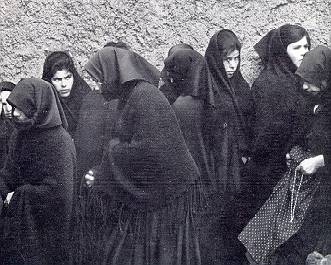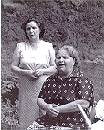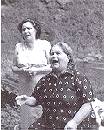| 1. Premise: gender, honor and
shame By the end of the 1950s a group of anthropologists, led by J. G. Peristiany, started a discussion about the existence of the Mediterranean as a territory characterized by some common features that assured its cultural homogeneity. One of the main publications that contributed to found the anthropology of the Mediterranean was the anthology Honour and Shame: The Values of Mediterranean Society edited by Peristiany (1966). Even if Peristiany and Pitt-Rivers have claimed recently that they have never meant "to establish the Mediterranean as a 'culture area'" (Peristiany and Pitt-Rivers 1992: 6), their previous statements about "the continuity and persistence of Mediterranean modes of thought" (Peristiany 1966: 9) were actually understood by the scholarly world as an implicit acknowledgement of the existence of such a unified entity. The so-called "honor and shame" syndrome was one of the most important "modes of thought" that Peristiany and his colleagues in 1966 assumed to be pan-Mediterranean: their belief was that "there exists a sex-linked, binary opposition in which honor is associated with men and shame with women" and both honor and shame are "inextricably linked, tied to one another in cognitive as well as affective terms" (Brandes 1987: 122). Since then this "syndrome" became constantly associated with Mediterranean studies. It could be argued that the articles included in the Peristiany volume are perhaps less unanimous than the editor states; they focus on different societies, chosen among the most marginal ones in the countries bordering on the Mediterranean so as "to tribalize" them; and finally, they exemplify the classical shortcomings of Mediterranean anthropology, namely, the "failure to compare, to make use of history, to work in cities, to relate part to whole" (Boissevain 1979: 81-82). In spite of these difficulties, the concept of a pan-mediterranean "honor and shame" syndrome soon became the "bread and butter" of Mediterranean anthropology. As Stanley Brandes wrote a decade ago: "We must beware of discovering honor and shame, as such, everywhere simply because we have learned that they are by definition Mediterranean. Until now, scholars felt duty-bound to encounter manifestations of these moral Bobsy twins when carrying out fieldwork any place in the Levant, North Africa, and Southern Europe" (Brandes 1987: 123). Still today, there is almost no anthropological study dealing with some Mediterranean society that fails to mention "honor and shame", sometimes simply as a link to previous literature (e.g. Abu-Lughod 1993), sometimes to support it (e.g. Gilmore 1987), or, more frequently, to criticize it (e.g. Dubisch 1995). I will not comment here on the "honor and shame" syndrome itself: many scholars have already done so, calling our attention to the following points: the two concepts of male honor and female shame are not consistent throughout the Mediterranean (e.g. Marcus 1987, Herzfeld 1987); they do not appear everywhere in these countries, while, on the other hand, they may be found elsewhere (e.g. Pina-Cabral 1989, Lever 1986); above all, these values appear to be rather obsolete in many Mediterranean regions today (e.g. Davis 1987). I would just add that a report on the ideas of Italian men about women published in 1965 (that is, around the time when the Peristiany volume also appeared) revealed that opinions about issues such as virginity, sexual behavior before and after marriage, adultery, divorce, etc., were contrasting in the different Italian regions (Parca 1965) and were far from confirming the existence of a unifying "honor and shame" syndrome. It would be still more problematic to maintain today that there are "modes of thought" concerning gender, not to say the "honor and shame" syndrome, that are common to all countries bordering on the Mediterranean. In spite of its shortcomings, the first literature on Mediterranean "honor and shame", when it is compared with most anthropological literature on non-Mediterranean countries appeared in the 1960s, represents an interesting early example of research on gender-based values. Since the "male" value of honor was thought to be inextricably linked to the "female" value of shame, the authors of that period had to take into consideration men as well as women, their roles in society and their mutual relationship. But how did the pioneers of Mediterranean anthropology portray women? Throughout the Mediterranean, women were portrayed as silent, passive, and marginal persons who were secluded in their houses, covered head to toe for the shame of their bodies, and apparently involved in no activity other than the silent display of their modesty.
An old photo of Sardinian women This representation soon became a stereotype that hindered a more thorough examination of the roles of women in Mediterranean societies. More importantly, this representation prevented many scholars from realizing that, while a part of the literature insisted on perpetuating the image of the chaste, secluded, mute "Mediterranean woman", the position of women was undergoing a dramatic change in most countries, as John Davis, for instance, has pointed out (Davis 1987: 22-34). When Gilmore in 1982 wrote that women are represented as "somehow foreign or isolated from the 'real life' of the community", he added that probably "we are caricaturing 50 percent of the Mediterranean world" (Gilmore 1982: 195). Jane Cowan also noticed recently, with reference to a town in Greek Macedonia, that "the selective insistence on the girl's confinement to the house is all the more striking in the context of the historical participation of Sohoian girls […] in agricultural production and in waged work outside the house" (Cowan 1990: 117). The participation of women in work outside the house was in fact widespread in Southern Europe, as confirmed also by the survey of women's musical repertoires: repertoires of songs that women performed (sometimes together with men) while, for instance, working in the fields were not rare in Euro-Mediterranean countries.
Thus, the ideal of female passivity and the image of women cloistered inside the house may have been widespread, but did not always correspond with reality. It would perhaps be more correct to assume that the general silence about what women say and do gives evidence to the low social weight assigned to their activities, compared with those of men (see Méndez 1988: 187). The same is true about the role of women in musical activities, one that has been often overlooked as an expression of female identity and values. Mediterranean women, as it is well known thanks to ethnomusicological literature and recordings, do practice many kinds of performing skills, which are for them important means of expression. We can say that symbolic forms of communication such as dance or songs were even more important in the past, when women enjoyed scarce freedom of expression in everyday life. Yet, they did not receive the same attention that was reserved for the more socially representative repertoires of Mediterranean men, even if we should keep in mind that the survey of male musical activity with regard to questions of gender is also still at the beginning. Indeed, one of the main goals of the meeting on "Music as Representation of Gender in Mediterranean Cultures" (Venice, July 11-13 1998), where this article was first presented as a paper, was to offer an opportunity to examine how certain musical practices in Mediterranean countries, both today and in the past, were effective in creating, representing, and perpetuating some specific gender roles. |


